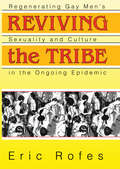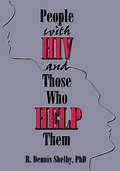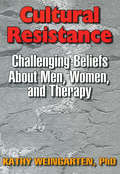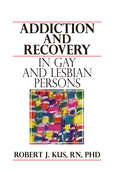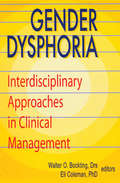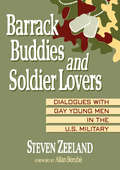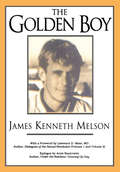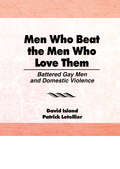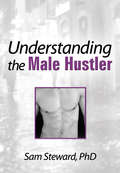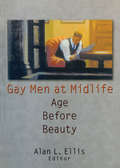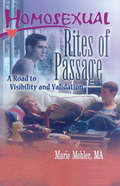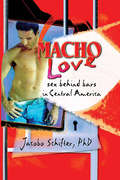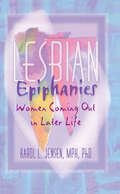- Table View
- List View
Reviving the Tribe: Regenerating Gay Men's Sexuality and Culture in the Ongoing Epidemic
by Eric RofesReviving the Tribe creates a rich and brutally honest portrait of contemporary gay men’s lives amidst the seemingly endless AIDS epidemic and offers both autobiographical self-examination and a relentless critique of current sexual politics within the gay community. Fearlessly confronting the horrors experiences by surviving gay men without giving way to hopelessness, denial, or blame, Reviving the Tribe offers an inspiring blueprint for the gay community which faces a continuing spiral of disaster.In Reviving the Tribe, Author Eric Rofes argues that a return to the interrupted agenda of gay liberation may provide long-term motivation to keep gay men alive and spur rejuvenation of new generations of gay culture. By interweaving social history, psychology, anthropology, epidemiology, sociology, feminist theory, and sexology with his own journey through the epidemic, Rofes provides a moving and compelling argument for stepping out of the “state of emergency” and embracing a life beyond disease. He boldly offers a plan for community regeneration focused on restoring mental health, reclaiming sexuality, and mending the social fabric of communal gay life. Rofes asks unspoken questions lurking in gay men&’s minds and suggests answers to these questions, hitting such controversial topics as: gay men&’s sex cultures of the 1970s why “educated” gay men continue to become HIV-infected changing forms of gay masculinity the opening of new sex clubs and bathhouses leaving “rage activism” behind links between the Holocaust and AIDS unacknowledged roots in the feminist movement of gay men’s AIDS response mass denial of chronic trauma among gay menThe refusal to confront the ever-intensifying manifestations of AIDS has seriously endangered the foundation of contemporary gay communities. Rofes argues that many gay men suffer from the ”disaster syndrome,” a psychologically determined response that defends individuals against being overwhelmed by traumatic experience. In Reviving the Tribe, he provides a radical critique of contemporary gay political culture and suggests alternatives which offer the opportunity to face history, grapple with decimation, and regenerate communal life.Cautioning that an honest analysis of recent gay history and urban cultures promises neither to stop gay men’s suffering nor to end continuing HIV infections, Reviving the Tribe provides gay men with a clear lens through which they might scrutinize their lives, come to a new understanding of the epidemic’s impact on their generation, and redirect activism. This courageous and inspiring work brings Rofes’commanding intellect and twenty years of grassroots gay activism to bear on the challenging task of reconstructing gay life in the new mellennium. Reviving the Tribe is filled with insight of special interest to gay men, lesbians involved in the mixed lesbian/gay movement, sociologists, public health workers, psychologists, counselors, sex educators, religious leaders, and AIDS prevention policymakers searching for fresh vision.
People With HIV and Those Who Help Them: Challenges, Integration, Intervention
by Carlton Munson R Dennis ShelbyIn this guidebook, People With HIV and Those Who Help Them, author Dennis Shelby uses the reported experiences of HIV-positive men to chart the course of living with HIV. He offers a consistent clinical-theoretical framework that encompasses the vast range of clinical problems clinicians may encounter in their work with HIV-positive individuals across the span of infection.This book provides a detailed account of the many psychological transformations that infected people experience. People With HIV and Those Who Help Them enables clinicians and students to better address the problems commonly encountered in clinical practice with persons with HIV. Clinicians will be able to gain perspective on the process of knowing one is infected, infected men will see their process mirrored and validated, and family, friends, and partners of infected men will gain a greater appreciation for the experience of their relative, friend, and partner. As clinicians have gained experience in working with HIV-positive people, they have become increasingly aware of the complexity of successful clinical intervention with HIV-related problems. In his book, Shelby “breaks down” this complex process into its component aspects: psychological impact of HIV infection the process of adapting to the knowledge of infection the dynamic process involved with HIV infection common problems and solutions encountered by infected people case examples that illustrate the clinical framework intensive psychotherapy and HIV infectionThe study that is the basis for this book charts the initial psychological impact and many changes and transformations of the experience of being HIV-positive. While infected people are often encouraged to maintain hopeful outlooks and to think of themselves as living with HIV rather than dying from it, it is often a long and arduous process to achieve and maintain this perspective. People With HIV and Those Who Help Them is a guide to help those with HIV to keep a positive outlook on life.
People With HIV and Those Who Help Them: Challenges, Integration, Intervention
by Carlton Munson R Dennis ShelbyIn this guidebook, People With HIV and Those Who Help Them, author Dennis Shelby uses the reported experiences of HIV-positive men to chart the course of living with HIV. He offers a consistent clinical-theoretical framework that encompasses the vast range of clinical problems clinicians may encounter in their work with HIV-positive individuals across the span of infection.This book provides a detailed account of the many psychological transformations that infected people experience. People With HIV and Those Who Help Them enables clinicians and students to better address the problems commonly encountered in clinical practice with persons with HIV. Clinicians will be able to gain perspective on the process of knowing one is infected, infected men will see their process mirrored and validated, and family, friends, and partners of infected men will gain a greater appreciation for the experience of their relative, friend, and partner. As clinicians have gained experience in working with HIV-positive people, they have become increasingly aware of the complexity of successful clinical intervention with HIV-related problems. In his book, Shelby “breaks down” this complex process into its component aspects: psychological impact of HIV infection the process of adapting to the knowledge of infection the dynamic process involved with HIV infection common problems and solutions encountered by infected people case examples that illustrate the clinical framework intensive psychotherapy and HIV infectionThe study that is the basis for this book charts the initial psychological impact and many changes and transformations of the experience of being HIV-positive. While infected people are often encouraged to maintain hopeful outlooks and to think of themselves as living with HIV rather than dying from it, it is often a long and arduous process to achieve and maintain this perspective. People With HIV and Those Who Help Them is a guide to help those with HIV to keep a positive outlook on life.
Cultural Resistance: Challenging Beliefs About Men, Women, and Therapy
by Kaethe WeingartenIn everyday life--in relationships, in various institutions, in texts--cultural premises influence and sometimes limit individuals’thoughts, actions, and ideas. Cultural Resistance: Challenging Beliefs About Men, Women, and Therapy analyzes cultural constraints and encourages therapists, individuals, and communities to practice cultural resistance on a daily basis, allowing for the realization of diverse and suppressed knowledges. Cultural Resistance shows general patterns by which some ideas in a culture become accepted and others are marginalized. It proposes ways individuals and communities can resist the hold of limiting ideas on their lives. In the postmodern tradition, Editor Kathy Weingarten brings together authors who ask and offer answers to the question, “What is not present in our thinking?” Each chapter invites therapists to extend their thinking about the scope of their work. Topics covered include: challenging cultural beliefs about mothers transforming masculine identities lesbian and gay parents a narrative approach to anorexia/bulimia perspectives on the Black woman and sexual trauma, focusing on Thomas v. Hill opening therapy to conversations with a personal god new conversations on controversial issuesThe chapters in Cultural Resistance first describe cultural premises that constrain the lives of women, men, and/or therapists and then develop an approach to resisting these constraints. A response follows each chapter in an effort to promote discourse, extend meanings, and encourage learning between professionals.Cultural Resistance yields new perspectives on the nature of social change and the relationships between individuals and culture. It offers valuable insights to family therapists, psychiatrists, psychologists, and social workers who want to broaden their thinking and approach. It gives therapists a fresh, new way of thinking about themselves, others, and their conversations through applications which may be professional, personal, or both.
Cultural Resistance: Challenging Beliefs About Men, Women, and Therapy
by Kaethe WeingartenIn everyday life--in relationships, in various institutions, in texts--cultural premises influence and sometimes limit individuals’thoughts, actions, and ideas. Cultural Resistance: Challenging Beliefs About Men, Women, and Therapy analyzes cultural constraints and encourages therapists, individuals, and communities to practice cultural resistance on a daily basis, allowing for the realization of diverse and suppressed knowledges. Cultural Resistance shows general patterns by which some ideas in a culture become accepted and others are marginalized. It proposes ways individuals and communities can resist the hold of limiting ideas on their lives. In the postmodern tradition, Editor Kathy Weingarten brings together authors who ask and offer answers to the question, “What is not present in our thinking?” Each chapter invites therapists to extend their thinking about the scope of their work. Topics covered include: challenging cultural beliefs about mothers transforming masculine identities lesbian and gay parents a narrative approach to anorexia/bulimia perspectives on the Black woman and sexual trauma, focusing on Thomas v. Hill opening therapy to conversations with a personal god new conversations on controversial issuesThe chapters in Cultural Resistance first describe cultural premises that constrain the lives of women, men, and/or therapists and then develop an approach to resisting these constraints. A response follows each chapter in an effort to promote discourse, extend meanings, and encourage learning between professionals.Cultural Resistance yields new perspectives on the nature of social change and the relationships between individuals and culture. It offers valuable insights to family therapists, psychiatrists, psychologists, and social workers who want to broaden their thinking and approach. It gives therapists a fresh, new way of thinking about themselves, others, and their conversations through applications which may be professional, personal, or both.
Addiction and Recovery in Gay and Lesbian Persons
by Robert J KusThis book provides chemical dependency clinicians a sampling of the work being done in the fields of gay and lesbian chemical dependency to enable clinicians to provide better care for their gay and lesbian clients.After an overview of 7 research studies which examine the incidence of alcoholism and/or chemical dependency in gay and lesbian persons, the contributing authors explore the special concerns of recovering gay and lesbian addicts.Chapters focus not only on issues in the fields of gay and lesbian chemical dependency but how clinicians can use this knowledge to better care for their gay and lesbian clients. Readers will find new information on: working with HIV positive persons homophobia as a critical root in chemically dependent gays and lesbians positive changes for dysfunctional relationships common with gays and lesbians spirituality in gay and lesbian communities the special needs of the rural gay/lesbian client gay men&’s groups in AA a retrospective of NALGAP resources and referrals for chemically dependent gay and lesbian personsAddiction and Recovery in Gay and Lesbian Persons assists social workers and other helping professionals working with chemically dependent clients learn more about how to adequately treat them. Gay and lesbian persons recovering from a chemical addiction will also find this book enlightening.
Addiction and Recovery in Gay and Lesbian Persons
by Robert J KusThis book provides chemical dependency clinicians a sampling of the work being done in the fields of gay and lesbian chemical dependency to enable clinicians to provide better care for their gay and lesbian clients.After an overview of 7 research studies which examine the incidence of alcoholism and/or chemical dependency in gay and lesbian persons, the contributing authors explore the special concerns of recovering gay and lesbian addicts.Chapters focus not only on issues in the fields of gay and lesbian chemical dependency but how clinicians can use this knowledge to better care for their gay and lesbian clients. Readers will find new information on: working with HIV positive persons homophobia as a critical root in chemically dependent gays and lesbians positive changes for dysfunctional relationships common with gays and lesbians spirituality in gay and lesbian communities the special needs of the rural gay/lesbian client gay men&’s groups in AA a retrospective of NALGAP resources and referrals for chemically dependent gay and lesbian personsAddiction and Recovery in Gay and Lesbian Persons assists social workers and other helping professionals working with chemically dependent clients learn more about how to adequately treat them. Gay and lesbian persons recovering from a chemical addiction will also find this book enlightening.
Gender Dysphoria: Interdisciplinary Approaches in Clinical Management
by Edmond J Coleman Walter O BocktingAn exploration of the diverse presentations of gender dysphoria and how it affects an individual's physical, psychological, social, and sexual adjustment, Gender Dysphoria provides comprehensive and applicable treatment approaches available for a wide spectrum of presentations of this disorder. The need for evaluating and treating gender dysphoria in the context of the gender dysphoric client's overall mental and physical health is stressed. International experts in the clinical management of gender dysphoria contribute valuable information on contemporary approaches in assessment, psychological and medical treatment, and adjustment of individuals with gender identity disorders. In Gender Dysphoria, clinicians will find important information on hormone therapy options and their physical results and side effects, and the effectiveness of sex reassignment surgery in improving a gender dysphoric client's adjustment. This comprehensive book covers a wealth of topics essential for clinicians who treat gender dysphoria, including:terminology and classification of gender identity disordersa validation of the “Cross-Gender Questionnaire,” a newly developed clinical assessment toolreported regrets of post-surgical transsexualsthe affective component of gender dysphoria in young boysa model for identifying and treating gender identity disorder in femalesa thorough description of a comprehensive treatment approach for a wide spectrum of presentations of gender dysphoria Filled with useful information on the clinical management of gender identity disorders, Gender Dysphoria meets the practical needs of clinical sexologists, psychotherapists, counselors, social workers, physicians, sex researchers, social scientists, and specialists who evaluate and treat gender dysphoria.
Gender Dysphoria: Interdisciplinary Approaches in Clinical Management
by Edmond J Coleman Walter O BocktingAn exploration of the diverse presentations of gender dysphoria and how it affects an individual's physical, psychological, social, and sexual adjustment, Gender Dysphoria provides comprehensive and applicable treatment approaches available for a wide spectrum of presentations of this disorder. The need for evaluating and treating gender dysphoria in the context of the gender dysphoric client's overall mental and physical health is stressed. International experts in the clinical management of gender dysphoria contribute valuable information on contemporary approaches in assessment, psychological and medical treatment, and adjustment of individuals with gender identity disorders. In Gender Dysphoria, clinicians will find important information on hormone therapy options and their physical results and side effects, and the effectiveness of sex reassignment surgery in improving a gender dysphoric client's adjustment. This comprehensive book covers a wealth of topics essential for clinicians who treat gender dysphoria, including:terminology and classification of gender identity disordersa validation of the “Cross-Gender Questionnaire,” a newly developed clinical assessment toolreported regrets of post-surgical transsexualsthe affective component of gender dysphoria in young boysa model for identifying and treating gender identity disorder in femalesa thorough description of a comprehensive treatment approach for a wide spectrum of presentations of gender dysphoria Filled with useful information on the clinical management of gender identity disorders, Gender Dysphoria meets the practical needs of clinical sexologists, psychotherapists, counselors, social workers, physicians, sex researchers, social scientists, and specialists who evaluate and treat gender dysphoria.
Barrack Buddies and Soldier Lovers: Dialogues With Gay Young Men in the U.S. Military
by Steven ZeelandAmong all the literature published on gays in the military, Steven Zeeland’s first book remains one of a kind. Barrack Buddies and Soldier Lovers is a raw, unsanitized personal record of conversations the author had with young soldiers and airmen stationed in Frankfurt, Germany. Zeeland’s intimate involvement with these men enabled him to document in honest, visceral terms the day-to-day reality of gay military men’s lives and how they work, play, and, in many instances, how the military actually helped them come out. Ironically, despite the military’s antigay policies, these men found that military service placed them in environments where they had to come to terms with their erotic feelings for other men, and sent them overseas to places where they found greater freedom to explore their sexuality than they could have back home. While a few of Zeeland’s buddies were targeted for discharge, most portray an atmosphere of sexually tense tolerance and reveal a surprising degree of openness with straight co-workers and roommates.The 16 fascinating interviews in Barrack Buddies and Soldier Lovers challenge popular assumptions and stereotypes about gay men in the military and provide significant information on: gay military sexual networks male sexual fluidity in barracks life strategies for survival as a gay or bisexual male in the U.S. military German-American relations attitudes toward the gay banThe casual, conversational structure of Barrack Buddies and Soldier Lovers makes it a richly entertaining read. No other book provides such a warm and intimate portrait of the lives of young gay soldiers and airmen.Visit Steven Zeeland at his home page: http://www.stevenzeeland.com
Barrack Buddies and Soldier Lovers: Dialogues With Gay Young Men in the U.S. Military
by Steven ZeelandAmong all the literature published on gays in the military, Steven Zeeland’s first book remains one of a kind. Barrack Buddies and Soldier Lovers is a raw, unsanitized personal record of conversations the author had with young soldiers and airmen stationed in Frankfurt, Germany. Zeeland’s intimate involvement with these men enabled him to document in honest, visceral terms the day-to-day reality of gay military men’s lives and how they work, play, and, in many instances, how the military actually helped them come out. Ironically, despite the military’s antigay policies, these men found that military service placed them in environments where they had to come to terms with their erotic feelings for other men, and sent them overseas to places where they found greater freedom to explore their sexuality than they could have back home. While a few of Zeeland’s buddies were targeted for discharge, most portray an atmosphere of sexually tense tolerance and reveal a surprising degree of openness with straight co-workers and roommates.The 16 fascinating interviews in Barrack Buddies and Soldier Lovers challenge popular assumptions and stereotypes about gay men in the military and provide significant information on: gay military sexual networks male sexual fluidity in barracks life strategies for survival as a gay or bisexual male in the U.S. military German-American relations attitudes toward the gay banThe casual, conversational structure of Barrack Buddies and Soldier Lovers makes it a richly entertaining read. No other book provides such a warm and intimate portrait of the lives of young gay soldiers and airmen.Visit Steven Zeeland at his home page: http://www.stevenzeeland.com
The Golden Boy
by Robert HatchThis is the first autobiography to be published by The Haworth Press.This is the first autobiography to be published by Harrington Park Press.The place is New York City. The time is the decade before the plague of AIDS. Thousands of gay men were living a free-wheeling lifestyle of club hopping, “score” hunting, sex without fear, and upward mobility. To none did The Big Apple offer greater rewards than to those young men who had the envied “male model” look.Author James Melson belonged to this exclusive clique: he was tall, blond, muscular, and very “straight looking.” He was a model at 19, and by 25, was a highly successful Wall Street banker. His good looks offered him immediate entry into exclusive clubs and onto the sexual fast track with actors, male models, and other members of the “Clique.”The author brings you behind the scenes into the lifestyle of the handsome “Clique”--providing details of the vigorous and entertaining excitement of the times. He exposes--for one of the few times in print--the lesser-known attitudes of the “Clique” and their disdain for “ugly faggots,” their obsession with strictly the chic and glamorous, and the fast lane life of partying and sex.For 200 pages, the reader is brought back to the era that for many older readers is just a memory, and for younger readers a time they never knew--when to be a “Golden Boy” was to be a prince, and sex was only fun and games.The Golden Boy autobiography ends when the author is diagnosed with AIDS, abandoned by a lover and friends, and left to look back on his life with a growing perspective.The role of “good looks” and people with AIDS is rarely talked about, particularly by gay survivors whose lesser appeal was once perhaps a curse but then ultimately their saving grace. This is not just another AIDS autobiography but a document dealing indirectly with this fact of life. The autobiography is introduced by Larry Mass, MD, an internationally recognized social historian/physician who examines the “Culture of Narcissism” in that era. Arnie Kantrowitz then presents an astonishingly frank and perhaps shocking Epilogue which will have many readers wanting to re-read the book.
The Golden Boy
by Robert HatchThis is the first autobiography to be published by The Haworth Press.This is the first autobiography to be published by Harrington Park Press.The place is New York City. The time is the decade before the plague of AIDS. Thousands of gay men were living a free-wheeling lifestyle of club hopping, “score” hunting, sex without fear, and upward mobility. To none did The Big Apple offer greater rewards than to those young men who had the envied “male model” look.Author James Melson belonged to this exclusive clique: he was tall, blond, muscular, and very “straight looking.” He was a model at 19, and by 25, was a highly successful Wall Street banker. His good looks offered him immediate entry into exclusive clubs and onto the sexual fast track with actors, male models, and other members of the “Clique.”The author brings you behind the scenes into the lifestyle of the handsome “Clique”--providing details of the vigorous and entertaining excitement of the times. He exposes--for one of the few times in print--the lesser-known attitudes of the “Clique” and their disdain for “ugly faggots,” their obsession with strictly the chic and glamorous, and the fast lane life of partying and sex.For 200 pages, the reader is brought back to the era that for many older readers is just a memory, and for younger readers a time they never knew--when to be a “Golden Boy” was to be a prince, and sex was only fun and games.The Golden Boy autobiography ends when the author is diagnosed with AIDS, abandoned by a lover and friends, and left to look back on his life with a growing perspective.The role of “good looks” and people with AIDS is rarely talked about, particularly by gay survivors whose lesser appeal was once perhaps a curse but then ultimately their saving grace. This is not just another AIDS autobiography but a document dealing indirectly with this fact of life. The autobiography is introduced by Larry Mass, MD, an internationally recognized social historian/physician who examines the “Culture of Narcissism” in that era. Arnie Kantrowitz then presents an astonishingly frank and perhaps shocking Epilogue which will have many readers wanting to re-read the book.
Men Who Beat the Men Who Love Them: Battered Gay Men and Domestic Violence
by Patrick Letellier David IslandDomestic violence in gay male relationships is the third largest health problem for gay men in America today. Men Who Beat the Men Who Love Them breaks the silence surrounding gay male domestic violence and exposes this hidden yet prevalent and destructive problem. The authors paint a vivid picture of gay men’s domestic violence, bringing its brutality to life by including personal narratives, written by one of the authors, by clearly defining what it is and what it is not through lists of violent acts and criminal code categories, and by thoroughly examining and analyzing the criminal, mental health, medical, political, and interpersonal issues involved. The authors boldly depart from the battered women’s literature by asserting that batterers have a diagnosable mental disorder, that battering is not gender based, and that much further criminalization of domestic violence is necessary.Striving for victim advocacy, the book underscores the idea that gay men’s domestic violence is totally unacceptable and is caused solely by individual abusive gay men who choose to batter. The book builds on and departs from what is known about domestic violence, with the authors challenging several fundamental premises in the literature, unabashedly identifying battering as a mental disorder. The authors explain that victims cannot stop their battering partners from battering and virtually all batterers choose to harm their partners in a premeditated fashion. The authors provide practical steps and suggestions for victims who want to leave and stay away from their violent partners and for friends who want to help battered gay men. Chapters describe the scope of the problem and refute myths and misconceptions. There are several detailed theory chapters in which the authors explain why gay men’s domestic violence occurs, who the batterers are, who the victims are at different stages of victimization, and how domestic violence can be stopped. A visionary, wide-ranging governmental and private plan of action is introduced, including lists of necessary laws and policies, as well as outlines of strong education, training, and advertising problems needed in various sectors of society. As a self-help book, Men Who Beat the Men Who Love Them provides practical information on a never-before discussed topic. As a trainer’s manual or teaching guide, it includes specific criteria for understanding the problem and for providing treatment.
Men Who Beat the Men Who Love Them: Battered Gay Men and Domestic Violence
by Patrick Letellier David IslandDomestic violence in gay male relationships is the third largest health problem for gay men in America today. Men Who Beat the Men Who Love Them breaks the silence surrounding gay male domestic violence and exposes this hidden yet prevalent and destructive problem. The authors paint a vivid picture of gay men’s domestic violence, bringing its brutality to life by including personal narratives, written by one of the authors, by clearly defining what it is and what it is not through lists of violent acts and criminal code categories, and by thoroughly examining and analyzing the criminal, mental health, medical, political, and interpersonal issues involved. The authors boldly depart from the battered women’s literature by asserting that batterers have a diagnosable mental disorder, that battering is not gender based, and that much further criminalization of domestic violence is necessary.Striving for victim advocacy, the book underscores the idea that gay men’s domestic violence is totally unacceptable and is caused solely by individual abusive gay men who choose to batter. The book builds on and departs from what is known about domestic violence, with the authors challenging several fundamental premises in the literature, unabashedly identifying battering as a mental disorder. The authors explain that victims cannot stop their battering partners from battering and virtually all batterers choose to harm their partners in a premeditated fashion. The authors provide practical steps and suggestions for victims who want to leave and stay away from their violent partners and for friends who want to help battered gay men. Chapters describe the scope of the problem and refute myths and misconceptions. There are several detailed theory chapters in which the authors explain why gay men’s domestic violence occurs, who the batterers are, who the victims are at different stages of victimization, and how domestic violence can be stopped. A visionary, wide-ranging governmental and private plan of action is introduced, including lists of necessary laws and policies, as well as outlines of strong education, training, and advertising problems needed in various sectors of society. As a self-help book, Men Who Beat the Men Who Love Them provides practical information on a never-before discussed topic. As a trainer’s manual or teaching guide, it includes specific criteria for understanding the problem and for providing treatment.
Understanding the Male Hustler
by Sam StewardThis book is a serious study of male hustlers using experiential dialogue to introduce the reader to real-life concepts and experiences that otherwise could not be effectively conveyed. An intriguing attempt to get into the mind and personality of the male hustler through a largely imagined series of dialogues between a well-known fictional hustler and his so-called amanuensis, Samuel Steward, this unique book covers all aspects of the hustler’s motivations, activities, life style, adjustments, advantages, and disadvantages. It accomplishes this dispassionately, without prejudgment, moral censure, approbation, or more than cursory involvement. Therapists and counselors in all fields of sexual functioning will find here some understanding of the causes and impulses (beyond the popular “broken home syndrome”) that lead young males into prostitution. It signals some of the signposts to danger and serious threats to health that accompany the profession of prostitution and also explains to counselors some of the activities and practices of the male prostitute, enabling them to have a better understanding of the fascination and peril of the hustler’s life. The brevity of success in such a calling is also considered, with some consideration for the necessity of long-range planning for the hustler’s future.Important contents: interview of a well-known hustler brief look at early male prostitution--Greek, Roman, Burton’s theory the peacock period and youth as a prerequisite for hustling lures of the profession--money, power, other motivations paths and mechanisms leading to hustling characteristics of different types of hustlers types of clients patronizing hustlers literary illuminations the modus operandi of the male hustler extraordinary dangers confronting the male hustler today the attractiveness of the “seeing-through” of a hustler to past clients quo vadis for the hustler after youth passes Readers will be amazed by the daily hazards and drawbacks as well fascinated by the curiosities and rewards of the hustler’s profession. Especially of interest to therapists and counselors, Understanding the Male Hustler is also valuable for sociologists, anthropologists, medical specialists, psychiatrists, psychologists.
Understanding the Male Hustler
by Sam StewardThis book is a serious study of male hustlers using experiential dialogue to introduce the reader to real-life concepts and experiences that otherwise could not be effectively conveyed. An intriguing attempt to get into the mind and personality of the male hustler through a largely imagined series of dialogues between a well-known fictional hustler and his so-called amanuensis, Samuel Steward, this unique book covers all aspects of the hustler’s motivations, activities, life style, adjustments, advantages, and disadvantages. It accomplishes this dispassionately, without prejudgment, moral censure, approbation, or more than cursory involvement. Therapists and counselors in all fields of sexual functioning will find here some understanding of the causes and impulses (beyond the popular “broken home syndrome”) that lead young males into prostitution. It signals some of the signposts to danger and serious threats to health that accompany the profession of prostitution and also explains to counselors some of the activities and practices of the male prostitute, enabling them to have a better understanding of the fascination and peril of the hustler’s life. The brevity of success in such a calling is also considered, with some consideration for the necessity of long-range planning for the hustler’s future.Important contents: interview of a well-known hustler brief look at early male prostitution--Greek, Roman, Burton’s theory the peacock period and youth as a prerequisite for hustling lures of the profession--money, power, other motivations paths and mechanisms leading to hustling characteristics of different types of hustlers types of clients patronizing hustlers literary illuminations the modus operandi of the male hustler extraordinary dangers confronting the male hustler today the attractiveness of the “seeing-through” of a hustler to past clients quo vadis for the hustler after youth passes Readers will be amazed by the daily hazards and drawbacks as well fascinated by the curiosities and rewards of the hustler’s profession. Especially of interest to therapists and counselors, Understanding the Male Hustler is also valuable for sociologists, anthropologists, medical specialists, psychiatrists, psychologists.
Gay Men at Midlife: Age Before Beauty
by John Dececco, Phd Alan L Ellis“Those of us in our forties and fifties came of age in the 1960s and 1970s--a time when the available commentary on gay life was anything but supportive. Until 1973, homosexuality was a diagnosable mental illness.” --from the Introduction by Alan L. EllisToday, that literary blindness is being remedied. Take an in-depth look into the lives of 15 gay men and how they relate to their own aging with Gay Men at Midlife: Age Before Beauty, a fascinating new book that explores and clarifies the issues that confront gay men as they age. What happens to gay men's lives when they reach middle age?The essays in Gay Men at Midlife: Age Before Beauty offer a realistic picture of both the challenges and the joys that present themselves in the lives of gay men at midlife. The book does not gloss over the difficulties of the experience; you will truly come to understand that each gay man is not alone in confronting the pain and mourning that may accompany middle age.The people who frankly, openly, and intelligently discuss their personal lives in Gay Men at Midlife: Age Before Beauty include: psychotherapist/popular columnist Tom Moon (San Francisco, California) professor of philosophy and literature Alejandro Medina-Bermudez (Madrid, Spain) television executive George Pierson (Bethesda, Maryland) multimedia artist Trevor Southey (born in the country now known as Zimbabwe, currently working in San Francisco) activist/researcher Frank Wong (New York) . . . plus 10 more individuals from varying backgrounds!Gay Men at Midlife: Age Before Beauty provides a look at how these individuals are redefining the stereotypes of aging gay men and empowering themselves to find meaning and purpose in the second half of their lives.
Gay Men at Midlife: Age Before Beauty
by John Dececco, Phd Alan L Ellis“Those of us in our forties and fifties came of age in the 1960s and 1970s--a time when the available commentary on gay life was anything but supportive. Until 1973, homosexuality was a diagnosable mental illness.” --from the Introduction by Alan L. EllisToday, that literary blindness is being remedied. Take an in-depth look into the lives of 15 gay men and how they relate to their own aging with Gay Men at Midlife: Age Before Beauty, a fascinating new book that explores and clarifies the issues that confront gay men as they age. What happens to gay men's lives when they reach middle age?The essays in Gay Men at Midlife: Age Before Beauty offer a realistic picture of both the challenges and the joys that present themselves in the lives of gay men at midlife. The book does not gloss over the difficulties of the experience; you will truly come to understand that each gay man is not alone in confronting the pain and mourning that may accompany middle age.The people who frankly, openly, and intelligently discuss their personal lives in Gay Men at Midlife: Age Before Beauty include: psychotherapist/popular columnist Tom Moon (San Francisco, California) professor of philosophy and literature Alejandro Medina-Bermudez (Madrid, Spain) television executive George Pierson (Bethesda, Maryland) multimedia artist Trevor Southey (born in the country now known as Zimbabwe, currently working in San Francisco) activist/researcher Frank Wong (New York) . . . plus 10 more individuals from varying backgrounds!Gay Men at Midlife: Age Before Beauty provides a look at how these individuals are redefining the stereotypes of aging gay men and empowering themselves to find meaning and purpose in the second half of their lives.
Homosexual Rites of Passage: A Road to Visibility and Validation
by Marie MohlerHomosexual Rites of Passage: A Road to Visibility and Validation will help you, as a gay or lesbian individual, work through identity issues, come out, and become visible in a healthy and safe manner. You will find this unique book to be an excellent resource for validation and support during your courageous acts of personal growth. Furthermore, you will discover a positive affirmation of homosexual identities as well as issues that impede or prevent your positive homosexual identity formation. Homosexual Rites of Passage facilitates your journey toward visibility and personal validation by naming fear and shame as obstacles of your growth and describing affirming homosexual rites of passage so that you will not feel alone in your journey through life. Throughout Homosexual Rites of Passage, you will explore the essential relationship between homosexual identity development and rites of passage, or life experiences or events that mark emotional, familial, and growth transitions in your life and that they are different for homosexuals than for heterosexuals. Compelling and informative, this important book discusses how homophobia and homosexuals’internalized shame often cause these rites of passage to be ignored or not considered valid rituals for gay men and lesbians. You will find helpful and insightful ideas in this informative book to help you affirm your homosexual identity, such as: discovering the definitions of the stages of homosexual identity formation and their significance in defining your view of self and others examining outlines and descriptions of obstacles that prevent positive homosexual identity development, such as fear, shame, and guilt learning to address the role and significance of rites of passage in creating personal identity and space analyzing the description of rites of passage that is specific to the homosexual community and that covers developmental milestones from birth to death, such as coming out or choosing a life partnerHomosexual Rites of Passage will assist your homosexual identity development through the celebration of homosexual rituals and rites of passage in a positive effective way. This valuable book addresses the issues that may impede your positive homosexual identity development and provides you with strategies to heal wounded and shamed identities, as well as providing you with a thorough description of homosexual rites of passage to help you understand and validate your homosexual identity.
Homosexual Rites of Passage: A Road to Visibility and Validation
by Marie MohlerHomosexual Rites of Passage: A Road to Visibility and Validation will help you, as a gay or lesbian individual, work through identity issues, come out, and become visible in a healthy and safe manner. You will find this unique book to be an excellent resource for validation and support during your courageous acts of personal growth. Furthermore, you will discover a positive affirmation of homosexual identities as well as issues that impede or prevent your positive homosexual identity formation. Homosexual Rites of Passage facilitates your journey toward visibility and personal validation by naming fear and shame as obstacles of your growth and describing affirming homosexual rites of passage so that you will not feel alone in your journey through life. Throughout Homosexual Rites of Passage, you will explore the essential relationship between homosexual identity development and rites of passage, or life experiences or events that mark emotional, familial, and growth transitions in your life and that they are different for homosexuals than for heterosexuals. Compelling and informative, this important book discusses how homophobia and homosexuals’internalized shame often cause these rites of passage to be ignored or not considered valid rituals for gay men and lesbians. You will find helpful and insightful ideas in this informative book to help you affirm your homosexual identity, such as: discovering the definitions of the stages of homosexual identity formation and their significance in defining your view of self and others examining outlines and descriptions of obstacles that prevent positive homosexual identity development, such as fear, shame, and guilt learning to address the role and significance of rites of passage in creating personal identity and space analyzing the description of rites of passage that is specific to the homosexual community and that covers developmental milestones from birth to death, such as coming out or choosing a life partnerHomosexual Rites of Passage will assist your homosexual identity development through the celebration of homosexual rituals and rites of passage in a positive effective way. This valuable book addresses the issues that may impede your positive homosexual identity development and provides you with strategies to heal wounded and shamed identities, as well as providing you with a thorough description of homosexual rites of passage to help you understand and validate your homosexual identity.
Macho Love: Sex Behind Bars in Central America
by Jacobo SchifterMacho Love: Sex Behind Bars in Central America is the first in-depth study of sexual culture and AIDS in Latin prisons. Psychologists, social workers, criminologists, and AIDS specialists will discover how the interplay of sexual ideals, prostitution, manipulation, resistance, and power relationships among prisoners and some staff are based on money, sex, drugs, and violence. Macho Love gives you a stirring and emotional look at the various risks and dangers lurking in the Latin American prison culture and discusses how Costa Rican and Central American prisons are improving the situation with new intervention programs. Fascinating and informative, Macho Love explores the dangerous Latin prison culture as it discusses: new HIV/AIDS prevention programs implemented in some Costa Rican and Central American prisons the frequency and types of prostitution and rape in prison drug and alcohol addiction and their effects on the spread of HIV/AIDS an understanding of why rehabilitation programs fail or succeed the lack of opportunities to work or to study that leaves the inmates vulnerable to the only freedom they have left--sex why a “cachero,” or a man who penetrates another man, is not considered a homosexual and often refuses to wear a condom, which tremendously increases the risk of HIV/AIDS Macho Love explores the life-threatening sexual culture in prisons to bring you the realities of the Latin prison culture. This revealing book examines the different types of relationships which occur in prisons and the factors that place inmates at risk for contracting the HIV virus, such as not wearing a condom because of intoxication due to drugs and alcohol. Macho Love also shows you how the new HIV/AIDS intervention programs in Costa Rica are combatting these serious problems to lower HIV infection rates and avoid the spread of this deadly and dangerous disease.
Macho Love: Sex Behind Bars in Central America
by Jacobo SchifterMacho Love: Sex Behind Bars in Central America is the first in-depth study of sexual culture and AIDS in Latin prisons. Psychologists, social workers, criminologists, and AIDS specialists will discover how the interplay of sexual ideals, prostitution, manipulation, resistance, and power relationships among prisoners and some staff are based on money, sex, drugs, and violence. Macho Love gives you a stirring and emotional look at the various risks and dangers lurking in the Latin American prison culture and discusses how Costa Rican and Central American prisons are improving the situation with new intervention programs. Fascinating and informative, Macho Love explores the dangerous Latin prison culture as it discusses: new HIV/AIDS prevention programs implemented in some Costa Rican and Central American prisons the frequency and types of prostitution and rape in prison drug and alcohol addiction and their effects on the spread of HIV/AIDS an understanding of why rehabilitation programs fail or succeed the lack of opportunities to work or to study that leaves the inmates vulnerable to the only freedom they have left--sex why a “cachero,” or a man who penetrates another man, is not considered a homosexual and often refuses to wear a condom, which tremendously increases the risk of HIV/AIDS Macho Love explores the life-threatening sexual culture in prisons to bring you the realities of the Latin prison culture. This revealing book examines the different types of relationships which occur in prisons and the factors that place inmates at risk for contracting the HIV virus, such as not wearing a condom because of intoxication due to drugs and alcohol. Macho Love also shows you how the new HIV/AIDS intervention programs in Costa Rica are combatting these serious problems to lower HIV infection rates and avoid the spread of this deadly and dangerous disease.
Lesbian Epiphanies: Women Coming Out in Later Life
by Karol L JensenExploring identity development and gender orientation, Lesbian Epiphanies: Women Coming Out in Later Life contains firsthand information about the experiences and difficulties of women who discover and reveal their newfound lesbian sexuality in later life. Psychologists, social workers, counselors, and professors will find that Lesbian Epiphanies is the first book to extensively quote from interviews of lesbians and bisexuals who had entered into heterosexual marriages. From the analysis of these 24 interviews, the psychological, erotic, and social processes of women who come out as lesbians or bisexuals after a heterosexual marriage are clearly explained so you can better assist your clients throughout this coming-out process. Discussing the personal and societal standards which clouded early self-awareness for these women, Lesbian Epiphanies lifts the veil of confusion to clearly illuminate the issues at hand to assist you in understanding and helping your clients. From the case studies in this important book, you will learn how some women came to realize their same gender attractions and the barriers they faced, including negative attitudes toward lesbian women and the lack of strong role models. Helpful and informative, Lesbian Epiphanies explores the development of sexual identity in women in the Unites States today and provides you with essential information to help you improve your services to lesbian and bisexual clients by: examining how the role of marriage in American culture stifles a woman’s self-awareness of her sexuality in order to help clients avoid the mistake of a heterosexual marriage before husbands and children are involved examining reasons behind the lack of valuable sexual information in America that limits a woman’s general awareness of herself, her body, her sexuality, and her life options understanding the challenges that lesbians and bisexuals experience when attempting to establish their true identities to assist your clients in overcoming these barriers suggesting support groups for clients who are having a difficult time becoming used to the ideas and feelings of some same gender attractionsThis insightful book knocks down the sociological and psychological barriers that keep women from realizing or acknowledging their real sexual orientation by dispelling societal and cultural myths about what it means to be a woman in the United States. Offering you invaluable advice on how to help clients effectively and happily live with their new identities, Lesbian Epiphanies provides solutions to the challenges that women experience in establishing their other-than-heterosexual orientation in a heterosexist society.
Lesbian Epiphanies: Women Coming Out in Later Life
by Karol L JensenExploring identity development and gender orientation, Lesbian Epiphanies: Women Coming Out in Later Life contains firsthand information about the experiences and difficulties of women who discover and reveal their newfound lesbian sexuality in later life. Psychologists, social workers, counselors, and professors will find that Lesbian Epiphanies is the first book to extensively quote from interviews of lesbians and bisexuals who had entered into heterosexual marriages. From the analysis of these 24 interviews, the psychological, erotic, and social processes of women who come out as lesbians or bisexuals after a heterosexual marriage are clearly explained so you can better assist your clients throughout this coming-out process. Discussing the personal and societal standards which clouded early self-awareness for these women, Lesbian Epiphanies lifts the veil of confusion to clearly illuminate the issues at hand to assist you in understanding and helping your clients. From the case studies in this important book, you will learn how some women came to realize their same gender attractions and the barriers they faced, including negative attitudes toward lesbian women and the lack of strong role models. Helpful and informative, Lesbian Epiphanies explores the development of sexual identity in women in the Unites States today and provides you with essential information to help you improve your services to lesbian and bisexual clients by: examining how the role of marriage in American culture stifles a woman’s self-awareness of her sexuality in order to help clients avoid the mistake of a heterosexual marriage before husbands and children are involved examining reasons behind the lack of valuable sexual information in America that limits a woman’s general awareness of herself, her body, her sexuality, and her life options understanding the challenges that lesbians and bisexuals experience when attempting to establish their true identities to assist your clients in overcoming these barriers suggesting support groups for clients who are having a difficult time becoming used to the ideas and feelings of some same gender attractionsThis insightful book knocks down the sociological and psychological barriers that keep women from realizing or acknowledging their real sexual orientation by dispelling societal and cultural myths about what it means to be a woman in the United States. Offering you invaluable advice on how to help clients effectively and happily live with their new identities, Lesbian Epiphanies provides solutions to the challenges that women experience in establishing their other-than-heterosexual orientation in a heterosexist society.
